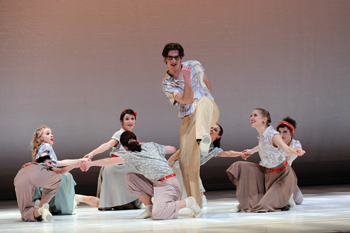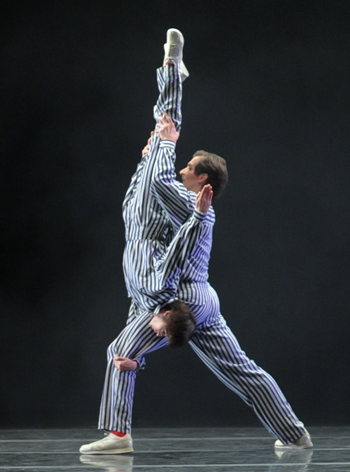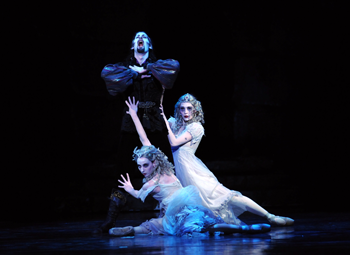Artist Spotlight: Stephen Hadala
|
|

|

|
Before retiring from the stage, Corps de ballet Dancer Stephen Hadala will make the final performance of his 16-year career with Pittsburgh Ballet Theatre during the 2013-2014 Season finale, “Don Quixote” with the PBT Orchestra.
Originally from Michigan, Hadala first came to PBT in 1998 as a PBT School student before joining the company later that year as an apprentice. Throughout his years with PBT, Hadala became known for his masterful portrayal of character roles ranging from the mysterious Drosselmeyer of “The Nutcracker” to the dramatic title role of PBT’s “Dracula.” Other featured roles include Dr. Coppélius in PBT’s “Coppélia,” Von Rothbart in “Swan Lake” and “Mitch” in the first performance by an American company of John Neumeier’s “A Streetcar Named Desire.” His repertoire also includes featured roles in Twyla Tharp’s “In the Upper Room” and Paul Taylor’s “Company B,” and he has also danced in and originated roles in every Dwight Rhoden work that has been created on the company during his 16-year tenure. Following the season, Hadala plans to move back to his hometown in the Detroit area with his wife, Maghen, and their son Ian. He and his sister will be taking leadership of the dance school where he began his own training, and he also plans to instruct dance at Marygrove College while completing a dual degree in fine arts in dance and business.
Hadala’s final role before retirement will be the character of Gamache, a wealthy (and comical) nobleman, who intends to marry Kitri but is halted by the valiant efforts of Don Quixote, Kitri herself, and her true love, Basilio. Here, Hadala reflects on his unexpected beginnings in ballet, his 16-year career with PBT and the many characters he has portrayed along the way.
Family: Wife, Maghen, and two-year-old son, Ian
Hobbies: “I like to cook….and I guess recently, just, playing with my son (Ian, 2), that’s the main hobby.”
What Ballet Means to me: “It’s transporting; it’s fulfilling; it’s difficult.”
Q&A
If you had to choose a favorite, which role stands out to you among the many you have made your own over the years?
“I’d have to say Mitch in A Streetcar Named Desire. Terry, and a lot of people who come through in setting different things, encourage finding a real person within any part no matter what kind of part it is…just finding that little bit of yourself…something that everyone can relate to. The process of rehearing and learning and performing A Streetcar Named Desire, it was that times ten. John Neumeier and the stager, Tamas, didn’t want any movement that was contrived. Everything had to be human and real no matter what – if you were dancing, if you were standing, if you were doing any sort of pantomime. I found that to be just the best experience, it was just really being able to dig in and truly find myself within that character. It was very challenging, the dancing was challenging and working with such a big name – John Neumeier – it was the first time the company did this ballet. It just felt like a lot to make it the best that it could be be. Difficult – but hands down, the most fulfilling and my favorite role to date.”
So many audience members will remember you for the many characters you’ve performed and often the humor you bring to those roles. How do you achieve that level of comedy?
“It’s tough, and I have to credit {Artistic Director Terrence S. Orr} in that respect, because he is really good at coaching. He’ll laugh out loud, and say,’ this is great, this is wonderful.’ And on the flip side of that, he’ll be like, ‘that’s just not funny, that doesn’t make sense, your character wouldn’t do that’…You just have to try every avenue. A lot of the time when we’re rehearsing, it’s just in front of your peers and the artistic staff. You just have to try different things and just see what really makes people laugh…”
What is the secret to your success with character roles and acting?
“I think that the secret I found is that you just have to check your insecurities, and your feelings of maybe looking foolish, just totally leaving yourself outside the studio. When you go in there, try absolutely everything, make a mistake. It’s through all of those kind of experiments – of what works and what doesn’t work – of where you find your character and find a cohesive person onstage.”
Dracula is another of your signature roles – on the other end of the spectrum. Are there are any interesting challenges that you encountered while developing that role?
“There were. Dracula is so iconic. The first act of the ballet is in Dracula’s lair. You actually kind of have to show a vulnerable, weaker side, because he hasn’t had fresh blood in a while. You have to be a dominant force, but kind of showing that dominant force how he would if he was weak and in need. It was a difficult balance. Once the third act comes, he’s already taken Flora…so he’s full tilt, a strong man.”
Focusing exclusively on dance and choreography, what are some of the ballets that stand out to you?
“Definitely, hands down, Twyla Tharp’s In the Upper Room. It was a physical challenge, it was a dancing challenge…a very fulfilling thing to accomplish, and I feel lucky to have been able to perform it two separate times. Paul Taylor’s Company B – it’s kind of an iconic ballet piece….just a really well-known and recognized piece of choreography. Glen Tetley’s Sacre, or The Rite of Spring – That’s another. It’s just 20 minutes of men non-stop jumping. You go on a cathartic journey. That’s another one that really stands out.”
What is the best thing that ballet has given you?
“Ballet…there’s dancing and class and performing, but actually the best thing that ballet has given me is finding out that I’m an artist. It’s more than just jumping and turning; it’s actually being an artist and being able to take the audience on a journey whether it’s through a story – like a ballet with a rich storyline – or it’s just contemporary movement that you can find your way to put emotion or feeling to.”
When you look back is there something that you’ll miss most about PBT and this company?
“Oh, absolutely. We’re a group of 29 dancers, so it’s a pretty tight-knit group, and everyone’s really friendly and supportive of one another and encouraging. I’m definitely going to miss that feeling of being in a group. I’m going to miss …when the curtain comes down on the last show, whatever we’re performing, it’s always exciting. I’ll miss the lots of hugs that we give.”
What do you think you’ll miss most about performing professionally full-time?
“Just knowing that five different times over the course of the year you’ll be onstage in front a full house, a lot of times with live music, whether it be a full orchestra or a jazz trio. Just the opportunities that come along with it to get onstage and to do your craft for a room full of people.”
What is your most memorable onstage moment that you can remember?
“There have been a lot. I think… going with In the Upper Room…It’s just such a physical, athletic piece, and just that feeling of accomplishment when you go running backwards at full speed at the end of the 9th movement, just that feeling of accomplishment… of being drenched in sweat head to toe. With the Stomper Men – the two other guys that I dance with – just feeling the camaraderie and the sense that we all did it. That definitely will always resonate with me.”
You’ve been with the company for 16 years. What would you say to your fans as you prepare to retire?
“Just, thank you for supporting the organization, supporting the different reps that we do…Without an audience, there’s no point in doing it.”
You’re pursuing teaching and sharing ballet with others. Why is it important for you to continue sharing this art form with others?
“I feel like I’ve gotten so much information on ballet technique, on performing, on creating new works, that I feel like I want to share all of that. Even at 36 years old, and in my last weeks of taking ballet class, I’m still learning new things, and I just want to share that information with as many students who are willing to listen to it.”
Any general reflections on the past 16 years?
“I didn’t seek out to be a ballet dancer, it just happened (Hadala was invited into the PBT School Pre-Professional Program and later into the company following a fortuitous meeting with PBT Artistic Director Terrence S. Orr during the company’s Detroit performance of Dracula on tour. His ballet teacher at the time, a former PBT ballerina, connected him with the artistic staff, who invited him to join the company for onstage warmup class before the performance. The rest is history.). So I’m just so thankful that it did happen. When {Artistic Director Terrence S. Orr} hired me, I was really rough around the edges as far as classical ballet technique was concerned. So, I’m just so thankful that he took a chance on me and he saw something, possibilities within myself that I didn’t even know that I had. That’s been an absolutely joy. I’ve been witness to live, great performances onstage, witnessing really talented dancers at the top of their craft. Just sharing the stage with them has been extraordinary.”
PHOTOS: RICH SOFRANKO

